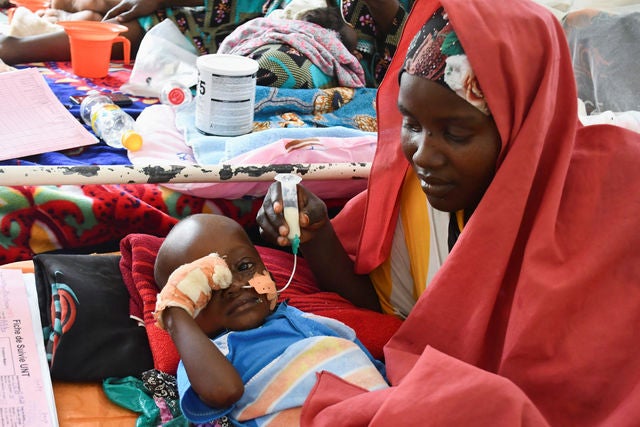Africa’s Year of Nutrition helped generate new political and funding commitments
African Union leaders notably signed the Abidjan Declaration to strengthen resiliency in nutrition and food security and keep nutrition a top priority

With the UN’s Sustainable Development Goal 2 of a world without hunger less than a decade away, African Union (AU) leaders last year doubled down on their commitments and designated 2022 as Africa’s Year of Nutrition. The union's 55 member states committed to “strengthening resilience in nutrition and food security on the African continent: strengthening agro-food systems, health and social protection systems for the acceleration of human, social and economic capital development.”
As we enter the new year, and the AU begins work on the Continental Nutrition Accountability Scorecard for 2023, officials have highlighted the progress made during the Year of Nutrition campaign, including increased political commitments to address nutrition challenges.
At the U.S.-African Leaders Summit in Lesotho in December, the country’s Prime Minister Samuel Ntsokoane Matekane said the Year of Nutrition had spurred increased awareness of the need to address malnutrition, including the adoption in December of the Abidjan Declaration in Cote d’Ivoire. "The declaration calls for accelerated investment, implementation, and coordination to improve nutrition and food security in Africa,” he said.
The declaration outlines a plan encompassing 18 interconnected areas, including prioritizing children in their first 1,000 days (from conception to their first birthday); multi-sectoral collaboration between governments, civil society, the public- private sector, and academia to accelerate progress on nutrition; the adoption of sustainable agrifood systems inclusive of drought-resistant foods; sanitation and drinking systems; and strengthening regulatory frameworks to ensure investments better address climate-related food and nutrition security.
“The commitment that countries are showing … is a very big issue. We are happy that we are seeing the right political support, that all the sectors are coming together – agriculture, health, education and nutrition,“ Mphumuzi Sukati, a senior nutrition and food system officer at the FAO’s Regional Office for Africa, also said at the time.
Several new investments also capped off the Year of Nutrition. USAID, for example, committed to spending US$760 million to “end hunger once and for all.” Isobel Coleman, USAID’s Deputy Administrator, said that through simple, evidence-based interventions, malnutrition was not only treatable but preventable.
At the U.S.-Africa Leaders' Summit in December in Washington, DC, Coleman said the landmark investment “could not have come at a more pivotal moment, as we face a global malnutrition crisis driven by a confluence of events, including the global pandemic, climate change, protracted humanitarian crises, and Russia’s unprovoked further invasion of Ukraine. The most severe impacts of this crisis have hit the Horn of Africa and the Sahel. This year, more than a million people were displaced in Somalia alone due to drought-induced hunger.”
The African Development Bank has also pledged to increase its nutrition investments from US$700 million in 2018 to US$2.8 billion, which it committed to spending on “nutrition-smart initiatives” over the next four years. The bank's Vice President Agriculture, Human and Social Development, Dr. Beth Dunford said, upon announcing the pledge, said the continent is at risk with 246 million people going to bed hungry every night. “The Year of Nutrition,” she said, “provided decision makers with the impetus to commit to strengthen the resilience of Africa’s agri-food, health, and social protection systems.”
Nutrition remains a pressing issue on the continent. According the African Union’s Continental Nutrition Accountability Scorecard, the continent has seen the number of stunted children increase from 50.6 million in 2000 to 58.7 million in 2019. In 2019, the continent accounted for 13.8 million of the world’s wasted children and 9.7 million of its overweight ones. And even though Africa’s share in the world’s undernourished population decreased from 35.5% in 1990 to 22% in 2019, the impacts caused by the continent’s rates of malnutrition are disruptive across societies, with African economies losing up to US$25 billion annually, which the Cost of Hunger in Africa Study estimated equals between 1.9% and 16.5% of AU countries’ GDP.
How can we help you?
believes that the quickest path to improving health outcomes to identify positive outliers in health and help leaders implement lessons in their own countries.
With our network of in-country and cross-country partners, we research countries that have made extraordinary progress in important health outcomes and share actionable lessons with public health decisionmakers.
Our research can support you to learn about a new issue, design a new policy, or implement a new program by providing context-specific recommendations rooted in Exemplar findings. Our decision-support offerings include courses, workshops, peer-to-peer collaboration support, tailored analyses, and sub-national research.
If you'd like to find out more about how we could help you, please click . Please consider so you never miss new insights from Exemplar countries. You can also follow us on Twitter and LinkedIn.
